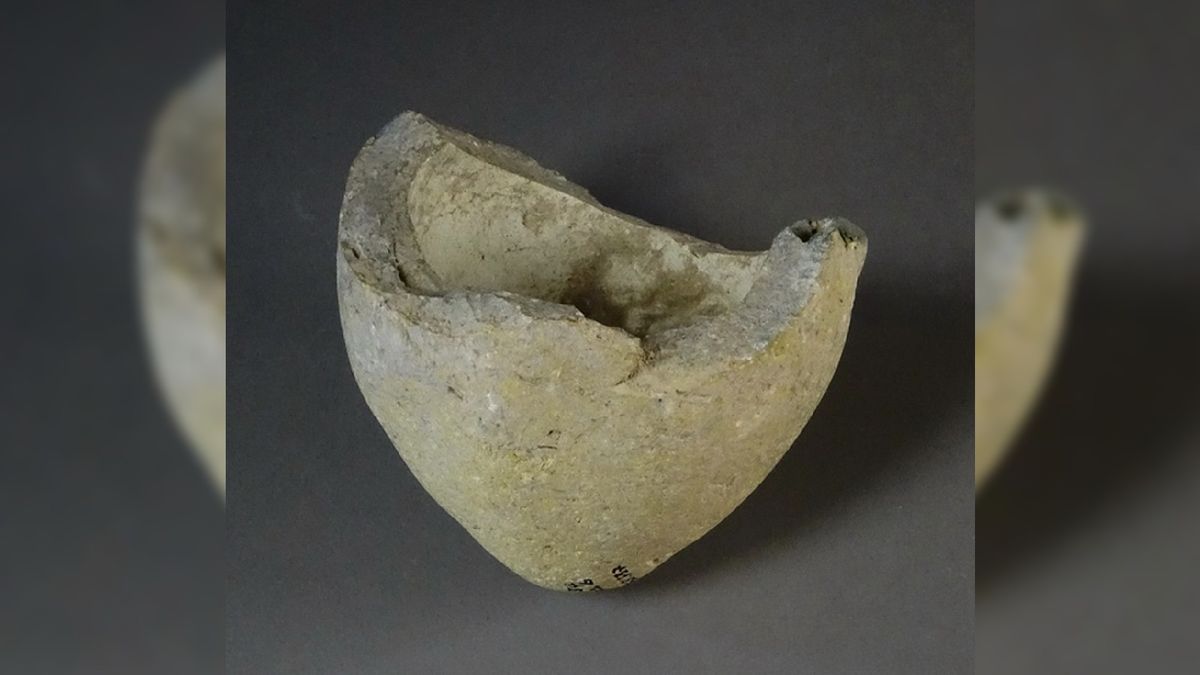A fragmented ceramic container uncovered in Jerusalem may be an early version of a hand grenade that warriors used during the Crusades around 900 years ago, a new study suggests.
Researchers studied fragments of jars known as sphero-conical containers — small, rounded vessels with a pointed end and an opening at the top. The sphero-conical shape was a common design for vessels in the Middle East at the time, the researchers said in a statement. The containers were used for a wide range of purposes, including to hold oils, medicines and mercury, to drink beer from, and more.
In the new study, researchers analyzed chemical remains found within four sphero-conical containers that were uncovered at a site called Armenian Gardens in Jerusalem and date to between the 11th and 12th centuries. The team found that one container was likely used to hold oil, another two stored scented materials, such as perfume or medicine, while the final container was laced with traces of explosive materials — hinting that it was used as a handheld explosive device.
This is not the first time researchers have suggested that hand grenades were used during the Crusades — a series of religious wars between 1095 and 1291 in which European Christians attempted to extend their influence over the Middle East. First-hand accounts from Crusader knights and passages from Arab texts mention the use of handheld devices that exploded with loud noises and a flash of light during the conflicts, according to the statement.
Related: 900-year-old Crusader sword discovered off coast of Israel
However, many archaeologists abandoned the idea that sphero-conical containers were used as hand grenades, mainly due to a lack of physical evidence.
“Since the 1980s, the idea that the containers were grenades fell out of favor as analysis started to identify other uses for these vessels,” study lead author Carney Matheson, a molecular archaeologist at Griffith University in Queensland, Australia, told Live Science. But the researchers of the new study remained open to the possibility that these containers were used as handheld explosives, he added.
Handheld explosives require three essential components; a fuel to burn, an oxidizer to help ignite the fuel, and a vessel that applies pressure, enabling the reaction between the fuel and oxidizer to increase in pressure until it causes an explosion, Matheson said.
The grenade-like vessel that the researchers analyzed had much thicker walls than the other ceramics they studied and showed signs of being sealed with resin, which points to it being well-suited to maintaining the pressure needed for an explosion to occur. However, to confirm that the jar was used as a grenade, the team also had to provide evidence of explosive materials inside.
Previously, researchers thought that any early handheld explosive devices would have likely contained black powder, also known as gunpowder, which uses charcoal as the fuel and potassium nitrate as the oxidizer. Black powder was invented in ancient China but was not introduced to the Middle East until the 13th century, which was after the vessel was made.
“One thought was that there may have been an earlier arrival of this black powder technology that was kept secret,” Matheson said. But the analysis showed that there were no black powder traces in the vessel.
Instead, the researchers found that the fuel used in the explosives was a mix of plant oils and animal fats, and the oxidizer was a mix of nitrates including sodium nitrate, calcium nitrate, potassium nitrate and magnesium nitrate. The team also found traces of sulfur, which was likely added to reduce the temperature needed for the explosive reaction to occur.
The researchers suspect that similar grenades held additional ingredients that would have altered the explosive characteristics, such as magnesium, which could have produced the bright flashes mentioned by witnesses, Matheson said.
However, it is not clear exactly how the explosive materials would have been ignited. “The ingredients could have been able to be detonated on impact, but we are not sure of that,” Matheson said. The team suspects that warriors threaded a fuse within a small crack found in the container that would have been held in place by resin, he added.
The new discovery highlights how diverse ancient ceramics were in terms of their design and purposes. “They [similar containers at the time] are classified as sphero-conical vessels based on their shape,” Matheson said. “But their manufacture, size, decorations and wall thickness vary enormously.”
The containers were also likely highly specialized, Matheson said. “I do not think the type that we identified as a grenade was used for anything else other than an explosive weapon.”
The researchers want to study similar containers found across the region to discover how common the explosives were, but they suspect that the grenades were less rare than people might think. “There are many fragments of the grenade type of ceramic found all over the Middle East so their number is likely very high,” Matheson said.
The study was published online April 25 in the journal PLOS One.
Originally published on Live Science.
Stay connected with us on social media platform for instant update click here to join our Twitter, & Facebook
We are now on Telegram. Click here to join our channel (@TechiUpdate) and stay updated with the latest Technology headlines.
For all the latest For Top Stories News Click Here

